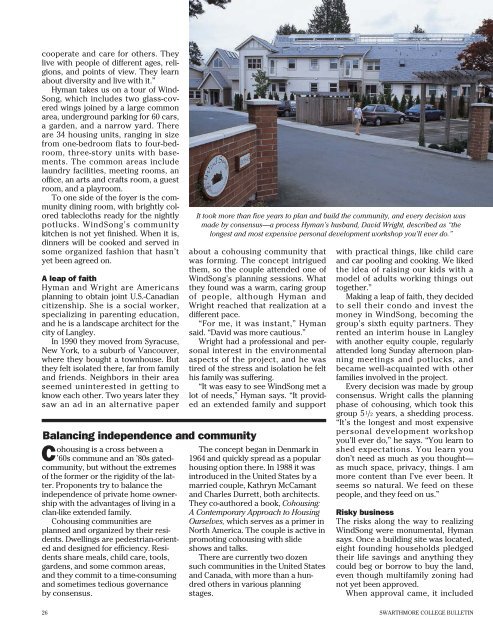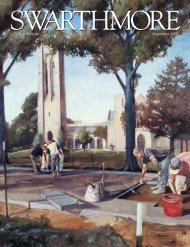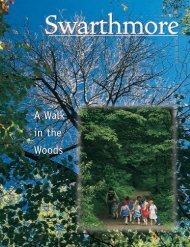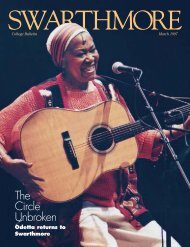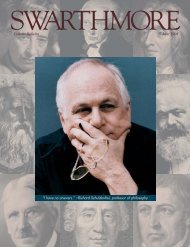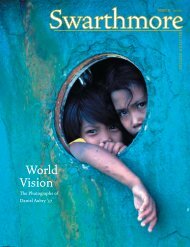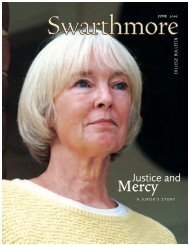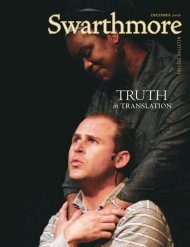September 1997 - Swarthmore College :: ITS
September 1997 - Swarthmore College :: ITS
September 1997 - Swarthmore College :: ITS
Create successful ePaper yourself
Turn your PDF publications into a flip-book with our unique Google optimized e-Paper software.
cooperate and care for others. They<br />
live with people of different ages, religions,<br />
and points of view. They learn<br />
about diversity and live with it.”<br />
Hyman takes us on a tour of Wind-<br />
Song, which includes two glass-covered<br />
wings joined by a large common<br />
area, underground parking for 60 cars,<br />
a garden, and a narrow yard. There<br />
are 34 housing units, ranging in size<br />
from one-bedroom flats to four-bedroom,<br />
three-story units with basements.<br />
The common areas include<br />
laundry facilities, meeting rooms, an<br />
office, an arts and crafts room, a guest<br />
room, and a playroom.<br />
To one side of the foyer is the community<br />
dining room, with brightly colored<br />
tablecloths ready for the nightly<br />
potlucks. WindSong’s community<br />
kitchen is not yet finished. When it is,<br />
dinners will be cooked and served in<br />
some organized fashion that hasn’t<br />
yet been agreed on.<br />
A leap of faith<br />
Hyman and Wright are Americans<br />
planning to obtain joint U.S.-Canadian<br />
citizenship. She is a social worker,<br />
specializing in parenting education,<br />
and he is a landscape architect for the<br />
city of Langley.<br />
In 1990 they moved from Syracuse,<br />
New York, to a suburb of Vancouver,<br />
where they bought a townhouse. But<br />
they felt isolated there, far from family<br />
and friends. Neighbors in their area<br />
seemed uninterested in getting to<br />
know each other. Two years later they<br />
saw an ad in an alternative paper<br />
about a cohousing community that<br />
was forming. The concept intrigued<br />
them, so the couple attended one of<br />
WindSong’s planning sessions. What<br />
they found was a warm, caring group<br />
of people, although Hyman and<br />
Wright reached that realization at a<br />
different pace.<br />
“For me, it was instant,” Hyman<br />
said. “David was more cautious.”<br />
Wright had a professional and personal<br />
interest in the environmental<br />
aspects of the project, and he was<br />
tired of the stress and isolation he felt<br />
his family was suffering.<br />
“It was easy to see WindSong met a<br />
lot of needs,” Hyman says. “It provided<br />
an extended family and support<br />
Balancing independence and community<br />
Cohousing is a cross between a<br />
’60s commune and an ’80s gatedcommunity,<br />
but without the extremes<br />
of the former or the rigidity of the latter.<br />
Proponents try to balance the<br />
independence of private home ownership<br />
with the advantages of living in a<br />
clan-like extended family.<br />
Cohousing communities are<br />
planned and organized by their residents.<br />
Dwellings are pedestrian-oriented<br />
and designed for efficiency. Residents<br />
share meals, child care, tools,<br />
gardens, and some common areas,<br />
and they commit to a time-consuming<br />
and sometimes tedious governance<br />
by consensus.<br />
It took more than five years to plan and build the community, and every decision was<br />
made by consensus—a process Hyman’s husband, David Wright, described as “the<br />
longest and most expensive personal development workshop you’ll ever do.”<br />
The concept began in Denmark in<br />
1964 and quickly spread as a popular<br />
housing option there. In 1988 it was<br />
introduced in the United States by a<br />
married couple, Kathryn McCamant<br />
and Charles Durrett, both architects.<br />
They co-authored a book, Cohousing:<br />
A Contemporary Approach to Housing<br />
Ourselves, which serves as a primer in<br />
North America. The couple is active in<br />
promoting cohousing with slide<br />
shows and talks.<br />
There are currently two dozen<br />
such communities in the United States<br />
and Canada, with more than a hundred<br />
others in various planning<br />
stages.<br />
with practical things, like child care<br />
and car pooling and cooking. We liked<br />
the idea of raising our kids with a<br />
model of adults working things out<br />
together.”<br />
Making a leap of faith, they decided<br />
to sell their condo and invest the<br />
money in WindSong, becoming the<br />
group’s sixth equity partners. They<br />
rented an interim house in Langley<br />
with another equity couple, regularly<br />
attended long Sunday afternoon planning<br />
meetings and potlucks, and<br />
became well-acquainted with other<br />
families involved in the project.<br />
Every decision was made by group<br />
consensus. Wright calls the planning<br />
phase of cohousing, which took this<br />
group 5 1/2 years, a shedding process.<br />
“It’s the longest and most expensive<br />
personal development workshop<br />
you’ll ever do,” he says. “You learn to<br />
shed expectations. You learn you<br />
don’t need as much as you thought—<br />
as much space, privacy, things. I am<br />
more content than I’ve ever been. It<br />
seems so natural. We feed on these<br />
people, and they feed on us.”<br />
Risky business<br />
The risks along the way to realizing<br />
WindSong were monumental, Hyman<br />
says. Once a building site was located,<br />
eight founding households pledged<br />
their life savings and anything they<br />
could beg or borrow to buy the land,<br />
even though multifamily zoning had<br />
not yet been approved.<br />
When approval came, it included<br />
26 SWARTHMORE COLLEGE BULLETIN


